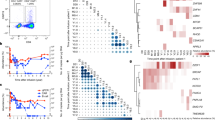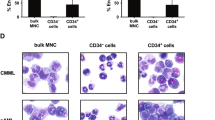Abstract
Two novel IL2-dependent cell lines, DERL-2 and DERL-7, were established from a patient with hepatosplenic γδ T cell lymphoma. This patient presented, at diagnosis, two discrete populations of CD56+ cells, one TCRγδ+, the second lacking T cell-restricted antigens. The cell lines derived displayed features corresponding to the two cellular components of the disease: DERL-2 was CD56+/CD3+/TcRγδ+ while DERL-7 was CD56+/CD3−/TcRγδ−. Along with CD56, the two cell lines shared the expression of CD7, CD2, CD158b and CD117. Karyotype analysis showed that both cell lines were near-diploid, with iso-7q and loss of one chromosome 10. In addition, DERL-2 showed 5q+ in all metaphases analyzed, while DERL-7 revealed loss of one chromosome 4. Genotypically, both cell lines shared the same STR pattern at nine loci and demonstrated an identical rearranged pattern of the T cell receptor genes β, γ and δ, with respect to the original tumor cells. These data indicated that both cell lines and the original neoplastic populations were T cell-derived and arose from a common ancestor. Among a large panel of cytokines tested, only SCF was able to substitute IL2 in supporting cell proliferation. Moreover, SCF and IL2 acted synergistically, dramatically enhancing cell growth. These cell lines may represent a model to further analyze the overlap area between T and NK cell malignancies, and may provide new information about the synergistic action of IL2 and SCF on normal and neoplastic T/NK cells.
This is a preview of subscription content, access via your institution
Access options
Subscribe to this journal
Receive 12 print issues and online access
$259.00 per year
only $21.58 per issue
Buy this article
- Purchase on Springer Link
- Instant access to full article PDF
Prices may be subject to local taxes which are calculated during checkout





Similar content being viewed by others
References
Spits WH, Lanier LL, Phillips JH . Development of human T and natural killer cells Blood 1995 85: 2654–2670
Robertson MJ, Ritz J . Biology and clinical relevance of human natural killer cells Blood 1990 76: 2421–2438
Jaffe ES . Classification of natural killer (NK) cell and NK-like T-cell malignancies Blood 1996 87: 1207–1210
Loughran TP Jr . Clonal disease of large granular lymphocytes Blood 1993 82: 1–14
Chan JK, Sin VC, Wong KF, Ng CS, Tsang WY, Chan CH, Cheung MM, Lau WH . Nonnasal lymphoma expressing the natural killer cell marker CD56: a clinicopathologic study of 49 cases of an uncommon aggressive neoplasm Blood 1997 89: 4501–4513
Emile JF, Boulland ML, Haioun C, Kanavaros P, Petrella T, Delfau-Larue MH, Bensussan A, Farcet JP, Gaulard P . CD5−CD56+ T-cell receptor silent peripheral T-cell lymphomas are natural killer cell lymphomas Blood 1996 87: 1466–1473
Drenou BD, Lamy T, Amiot L, Fardel O, Caulet-Maugendre S, Sasportes M, Diebold J, Le Prisé PY, Fauchet R . CD3−CD56+ non-Hodgkin lymphomas with an aggressive behavior related to multidrug resistance Blood 1997 89: 2966–2974
Macon WR, Williams ME, Greer JP, Hammer RD, Glick AD, Collins RD, Cousar JB . Natural killer-like T-cell lymphomas: aggressive lymphomas of T-large granular lymphocytes Blood 1996 87: 1474–1483
Gentile TC, Uner AH, Hutchison RE, Wright J, Ben-Ezra J, Russell EC, Loughran TP Jr . CD3+CD56+ aggressive variant of large granular lymphocyte leukemia Blood 1994 84: 2315–2321
Farcet JP, Gaulard P, Marolleau JP, Le Couedic JP, Henni T, Gourdin MF, Divine M, Haioun C, Zafrani S, Goossens M, Hercend T, Reyes F . Hepatosplenic T-cell lymphoma: sinusal/sinusoidal localization of malignant cell expressing the T-cell receptor γδ Blood 1990 75: 2213–2219
Camera A, Pezzullo L, Villa MR, Luciano L, Pane F, Izzo B, Boccuni P, Di Noto R, Del Vecchio L, Salvatore F, Rotoli B . Coexistence of two distinct cell populations (CD56+TcRγδ+ and CD56+TcRγδ−) in a case of aggressive CD56+ lymphoma/leukemia Haematologica 2000 85: 496–501
Drexler HG, Matsuo Y . Guidelines for the characterization and publication of human malignant hematopoietic cell lines Leukemia 1999 13: 835–842
Di Noto R, Luciano L, Lo Pardo C, Ferrara F, Frigeri F, Mercuro O, Lombardi ML, Pane F, Vacca C, Manzo C, Salvatore F, Rotoli B, Del Vecchio L . JURL-MK1 (c-kit high/CD30−/CD40−) and JURL-MK2 (c-kit low/CD30+/CD40+) cell lines: ‘two sided’ model for investigating leukemic megakayocytopoiesis Leukemia 1997 11: 1554–1564
Pastore L, Vuttariello E, Sarrantonio C, Coto I, Roviello S, Fortunato G, Salvatore F, Sacchetti L . Allele frequency distributions at several variable number of tandem repeat (VNTR) and short tandem repeat (STR) loci in a restricted Caucasian population from south Italy and their evaluation for paternity and forensic use Mol Cell Probes 1996 10: 299–308
Sacchetti L, Calcagno G, Coto I, Tinto N, Vuttariello E, Salvatore F . Efficiency of two different nine-loci short tandem repeat systems for DNA typing purposes Clin Chem 1999 45: 178–183
Seabright M . A rapid banding technique for human chromosomes Lancet 1971 II: 971–972
Mitelman F (ed) . ISCN Guidelines for Cancer Cytogenetics in An Intemational System for Human Cytogenetic Nomenclature Karger: Basel 1995
Sambrook J, Fritsch, EF, Maniatis T . Molecular Cloning: a Laboratory Manual 2nd edn Cold Spring Harbor Laboratory Press: New York 1989
Duby AD, Klein KA, Murre C, Scidman JC . A novel mechanism of somatic rearrangement predicted by a human T-cell antigen receptor β-chain complementary DNA Science 1985 228: 1204–1206
Quertemous T, Murre C, Dialynas D, Duby AD, Strominger JL, Waldman TA, Seidman JG . Human T-cell γ-chain genes: organization, diversity and rearrangement Science 1986 231: 252–255
Boehm T, Baer R, Lavenir I, Forster A, Waters JJ, Nacheva E, Rabbitts TH . The mechanism of chromosomal translocation t(11;14) involving the T-cell receptor Cδ locus on human chromosome 14q11 and a transcribed region of chromosome 11q15 EMBO J 1988 7: 385–394
Herbst H, Niedobitek G, Kneba M, Hummel M, Finn T, Anagnostopoulos I, Bergholz M, Krieger G, Stein H . High incidence of Epstein–Barr virus genomes in Hodgkin's disease Am J Pathol 1990 137: 13–18
Oksenhendler E, Carcelain G, Aoki Y, Boulanger E, Maillard A, Clauvel JP, Agbalika F . High levels of human herpesvirus 8 viral load, human interleukin-6, interleukin-10, and C-reactive protein correlate with exacerbation of multicentric Castelman disease in HIV-infected patients Blood 2000 96: 2069–2073
Goudsmit J, Renwick N, Dukers N, Coutinho R, Heisterkamp S, Bakker M, Schulz T, Cornelissen M, Weverling G . human herpesvirus 8 infections in the Amsterdam cohort studies (1984–1997): analysis of seroconversion to ORF65 and ORF73 Proc Natl Acad Sci USA 2000 97: 4838–4843
Chadburn A, Athan E, Wieczorek R, Knowles DM . Detection and characterization of human T-cell lymphotropic virus type I (HTLV-I) associated T-cell neoplasm in an HTLV-I nonendemic region by plymerase chain reaction Blood 1991 77: 2419–2430
Brando B, Barnett D, Janossi G, Mandy F, Autran B, Rothe G, Scarpati B, D'Avanzo G, D'Hautcourt J, Lenkei R, Schmitz G, Kunkl A, Chianese R, Papa S, Gratama JW . Cytofluorometric methods for assessing absolute numbers of cell subsets in blood Cytometry 2000 42: 327–346
Papa S, Vitale M, Mariani AR, Roda P, Facchini A, Manzoli FA . Natural killer function in flow cytometry. I. Evaluation of NK lytic activity on K562 cell line J Immunol Meth 1988 107: 73–78
Drexler HG, Matsuo Y . Malignant hematopoietic cell lines: in vitro models for the study of natural killer cell leukemia–lymphoma cell lines Leukemia 2000 14: 777–782
Drexler HG . The Leukemia–Lymphoma Cell Line Facts Book Academic Press: London 2000
Tommasello E . CD69 Workshop Panel report In: Kishimoto T (ed.) Leukocyte Typing VI. White Cell Differentiation Antigens 1997 pp 277–279
Hegen M . CD26 Workshop Panel report. In: Kishimoto T (ed.) Leukocyte Typing VI. White Cell Differentiation Antigens 1997 pp 478–481
Ruiz P, Mailhot S, Delgado P, Amador A, Viciana AL, Ferrer L, Zacharievich N . CD26 expression and dipeptidyl peptidase IV activity in an aggressive hepatosplenic T-cell lymphoma Cytometry 1998 34: 30–35
Reyburn H, Mandelboim O, Valés-Goméz M, Sheu EG, Pazmany L, Davis DM, Strominger JL . Human NK cells: their ligands, receptors and functions Immunol Rev 1997 155: 119–125
D'Andrea A, Chang C, Phillips JH, Lanier LL . Regulation of T cell lymphokine production by killer cell inhibitory receptor recognition of self HLA class I alleles J Exp Med 1996 184: 789–794
Moretta A, Vitale M, Bottino C, Orengo AM, Morelli L, Augugliaro R, Barbaresi M, Ciccone E, Moretta L . P58 molecules as putative receptors for major histocompatibility complex (MHC) class I molecules in human natural killer (NK) cells. Anti-p58 antibodies reconstitute lysis of MHC class I-protected cells in NK clones displaying different specificities J Exp Med 1993 178: 597–604
Matos ME, Schnier GS, Beecher MS, Ashman LK, William DE, Caligiuri MA . Expression of a functional c-kit receptor on a subset of natural killer cells J Exp Med 1993 178: 1079–1084
Alonsozana ELC, Stamberg J, Kumar D, Jaffe ES, Medeiros LJ, Frantz C, Schiffer CA, O'Cornell BA, Kerman S, Stass SA, Abruzzo LV . Isochromosome 7 q: the primary cytogenetic abnormality in hepatosplenic γδ T cell lymphoma Leukemia 1997 11: 1367–1372
Wang CC, Tien HF, Lin MT, Sun IJ, Wang CH, Chuang SM, Shen MC, Liu CH . Consistent presence of isochromosome 7 q in hepatosplenic T γδ lymphoma: a new cytogenetic–clinicopathologic entity Genes Chromosom Cancer 1995 12: 161–164
Ansell SM, Dewald GW, Norby SM, Witzig TE, Li CY, Hanson CA, Phyliky RL . Hepatosplenic γδ T cell lymphoma: cytogenetic abnormalities may predict clinical outcome Blood 1997 10: (Suppl. 1) Abstr. 3867
Wong KF, Chan JKC, Kwong YL . Identification of del(6) (q21q25) as a recurring chromosomal abnormality in putative NK cell lymphoma/leukaemia Br J Haematol 1997 98: 922–926
Kees UR, Ashman LK . Synergistic action of interleukin-2 and Steel factor (SLF) on a human T lymphoblastoid cell line Leukemia 1995 9: 1046–1050
Fehninger TA, Carson WE, Mrozek E, Caligiuri MA . Stem cell factor enhances interleukin-2-mediated expansion of murine natural killer cells in vivo Blood 1997 90: 3647–3653
Nagashima S, Mailliard R, Kashii Y, Reichert TE, Herberman RB, Robbins P, Whiteside TL . Stable transduction of the interleukin-2 gene into natural killer cell lines and their phenotypic and functional characterization in vitro and in vivo Blood 1998 91: 3850–3861
Colucci F, Di Santo JP . The receptor tyrosine kinase c-kit provides a critical signal for survival, expansion, and maturation of mouse natural killer cells Blood 2000 95: 984–991
Kojima HK, Suzukawa K, Yatabe Y, Hori M, Nagasawa T, Abe T . Establishment of a new natural killer (NK) cell line, TKS-1, from a patient with aggressive type of large granular lymphocyte (LGL) leukemia Leukemia 1994 8: 1999–2004
Gong JH, Maki G, Klingemann HG . Characterization of a human cell line (NK-92) with phenotypical and functional characteristics of activated natural killer cells Leukemia 1994 8: 652–658
Tsuchiyama J, Yoshino T, Mori M, Kondoh E, Oka T, Akagi T, Hiraki A, Nakayama H, Shibuya A, Ma Y, Kawabata T, Okada S, Harada M . Characterization of a novel human natural killer-cell line (NK-YS) established from natural killer cell lymphoma/leukemia associated with Epstein–Barr virus infection Blood 1998 92: 1374–1383
Acknowledgements
This work was supported in part by grants from Biogem and PRIN (MURST, Rome), AIRC (Milan), CNR (Rome), Regione Campania, and POP 94–99 Regione Molise.
Author information
Authors and Affiliations
Rights and permissions
About this article
Cite this article
Noto, R., Pane, F., Camera, A. et al. Characterization of two novel cell lines, DERL-2 (CD56+/CD3+/TCRγδ+) and DERL-7 (CD56+/CD3−/TCRγδ−), derived from a single patient with CD56+ non-Hodgkin's lymphoma. Leukemia 15, 1641–1649 (2001). https://doi.org/10.1038/sj.leu.2402239
Received:
Accepted:
Published:
Issue Date:
DOI: https://doi.org/10.1038/sj.leu.2402239
Keywords
This article is cited by
-
DERL2 (derlin 2) stabilizes BAG6 (BAG cochaperone 6) in chemotherapy resistance of cholangiocarcinoma
Journal of Physiology and Biochemistry (2024)
-
Aggressive natural killer-cell leukemia mutational landscape and drug profiling highlight JAK-STAT signaling as therapeutic target
Nature Communications (2018)
-
Transgenic mice overexpressing the wild-type form of the HMGA1 gene develop mixed growth hormone/prolactin cell pituitary adenomas and natural killer cell lymphomas
Oncogene (2005)



